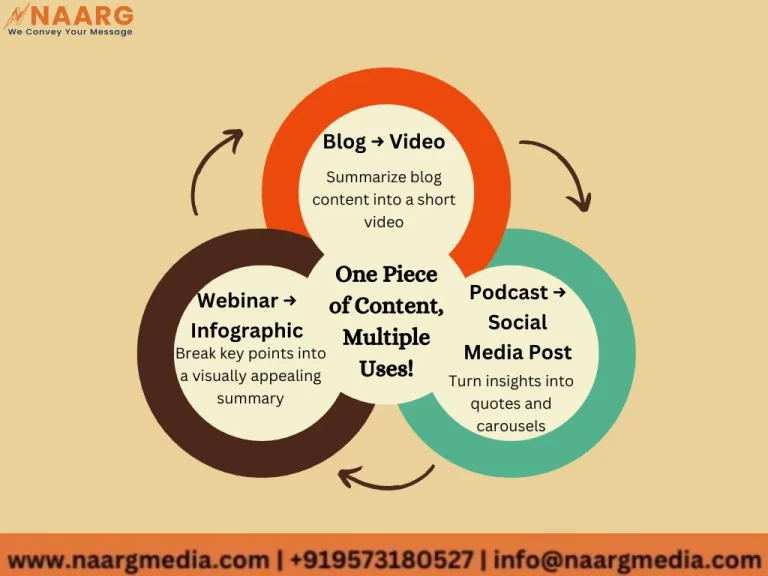Imagine spending over 5 hours writing a well-researched blog post—only to find that, after a few weeks, it’s no longer appreciated. Isn’t that frustrating? Wouldn’t it be fantastic to recycle, remake, and keep it alive on various platforms instead of letting it fade away on the web?
That’s precisely the point of content repurposing. Content repurposing is the most innovative way to extend the value of existing content without constantly creating something new.
Instead of always coming up with new ideas, you utilize the already available content and transform it into a different format.
A single blog post can turn into:
- YouTube video
- LinkedIn post
- Twitter thread
- Email newsletter
- Podcast episode
- Pinterest infographic
And the good part?
It can also help you save time, increase engagement, and bring in more visitor traffic. According to HubSpot, businesses that repurpose their content get 3X more engagement than those that don’t.
So let us analyze a bit deeper what content repurposing is, why it is so important, and how you can do it like a professional!

What is Content Repurposing?
Did you know that, businesses that recycle content are 60% more likely to witness an increase in audience engagement as opposed to those that do not?
Content repurposing is the procedure of taking available content and shaping it into various forms to attract new readers.
Imagine it as content upcycling-touching up a bit, or being able to give the old content a new life, and add it up with more precision.
Instead of not getting appreciated for their hard work after a week, repurpose the same concepts so that people can listen to them on various platforms.
For instance:
- A long YouTube video → Changed into the short Instagram Reels.
- The blog post → Transformed into the LinkedIn carousel post.
- A podcast episode → Changed to the Twitter thread.
- A data-heavy report → Transform into an infographic for Pinterest.
Why is this important?
People have different preferences for consuming text content. While some prefer blogs, others favor shorter videos.
The concept of content repurposing enables you to share your message in the format that resonates most with your audience.

Why is Content Repurposing Important?
1. Saves Time and Effort
Continuously creating new content can be exhausting and time-consuming.
Content repurposing allows you to work smarter, not harder, by applying the same concepts in various ways.
2. Expands Reach & Engagement
Not all people read blogs and not everyone watches videos.
When you repurpose your content, you tap into new audiences on multiple platforms and enhance your interaction with them.
3. Boosts SEO & Website Traffic
By reusing blog posts as LinkedIn articles or guest posts you get backlinks and thus, improve your SEO ranking.
If your content is found in many different places, it has a higher possibility of bringing more traffic to your website.
4. Makes Your Content Evergreen
Content is not a one-time thing. By updating and using the content in a variety of ways, it becomes more relevant and stays longer in the ecosphere.
5. Maximizes ROI on Content Creation
If working for hours on a blog post, why not get 10X more value out of it?
Content repurposing makes sure that each piece of content puts more effort into your business.
How to Prepare for Content Repurposing
Before starting to repurpose content, make sure you follow these outlined steps to make the process smooth and effective:
Step 1: Identify High-Performing Content
Scan your Google Analytics, LinkedIn insights, and Instagram statistics to see which content brings the maximum audience engagement.
Step 2: Understand Your Audience’s Preferences
Would you say they prefer video, text, or audio? The good thing is your content can always be tailored to the formats they like.
Step 3: Choose the Right Platforms
There are contents that Instagram is best suited for, while there are others that are more appropriate for LinkedIn and Twitter.
Pick the right platform for each kind of content.
Step 4: Update & Refresh Content
Before repurposing, upgrade the content with new facts, insights, or case studies for it to remain fresh.
Step 5: Repurpose with a Purpose
It is not about copy-pasting but rather adapting your content to different platforms and formats.
Example: A detailed blog post → can be split into 5 LinkedIn posts, 3 Twitter threads, and a YouTube video.
Strategies for Effective Content Repurposing
Here are the most effective means of repurposing content to start with:
1. Turn Blog Posts into Videos & Reels
Take the essential points of the blogs and transform them into very short Instagram Reels, YouTube Shorts, or TikToks. Tools such as Canva, InVideo, or CapCut are very helpful in the creation of videos.
2. Convert Videos into Blog Posts
Get the concepts from a YouTube video or webinar and repurpose them into a well-written blog or LinkedIn article.
3. Transform Blog Content into Podcast Episodes
In case your blog content is informative, turning it into a podcast conversation would be a good idea. Employ applications like Anchor or Audacity for simple recording.
4. Design Infographics from Data-Heavy Content
If you possess a blog that has essential information units, make it into a Pinterest infographic and an interesting Twitter post.
5. Republish & Syndicate Your Content
Post articles on content syndication platforms like LinkedIn Articles, Medium, and Quora, to attract the audience.
6. Create Carousels & Slideshows for LinkedIn & Instagram
Convert the main points of blogs into slideshows and share them on Instagram & LinkedIn.
Pro Tip:
Atomization of content is a simple but brilliant way to divide a large piece of content into a series of small bite-sized pieces, each made to fit a different platform.
Tools for Content Repurposing
To make content repurposing easier, here are some of the best tools:
1. Canva
For creating infographics, social media posts, and carousels.
2. InVideo
For turning blog posts into engaging videos.
3. Anchor
For converting blogs into podcast episodes.
4. Otter.ai
For transcribing videos into blog content.
5. Hootsuite
For scheduling and repurposing social media content across multiple platforms.
6. QuillBot
For paraphrasing content while keeping the essence intact.
7. Medium & LinkedIn Articles
For content redistribution and expanding your reach.
Fun Fact:
A single blog post can be reused in at least 10 different content formats across many platforms!
Writing new content every time is tiring.
But, repurposing your content can change your life—you can convert a single perfect piece into various formats, which makes it possible for more people to get in touch with you without the need to work twice as hard.
Just think of this activity as if you were making extra money out of the most sustainable ideas you have instead of permanently being on a spinning wheel of new content.
But here’s the catch:
repurposed content is not only a time-saver but also increases readership, enhances SEO, and makes your brand visible on multiple platforms.
Why waste your precious content and just leave it lying around instead of giving it a new life?
If you are not repurposing your content yet, then you are probably unaware that you are losing potential profits.
Begin today by:
- Find out what kind of content was most successful in your case.
- Picking different formats to convert it into.
- Utilizing the tools of repurposing to make the process easier.
For more such information. Contact us today.

